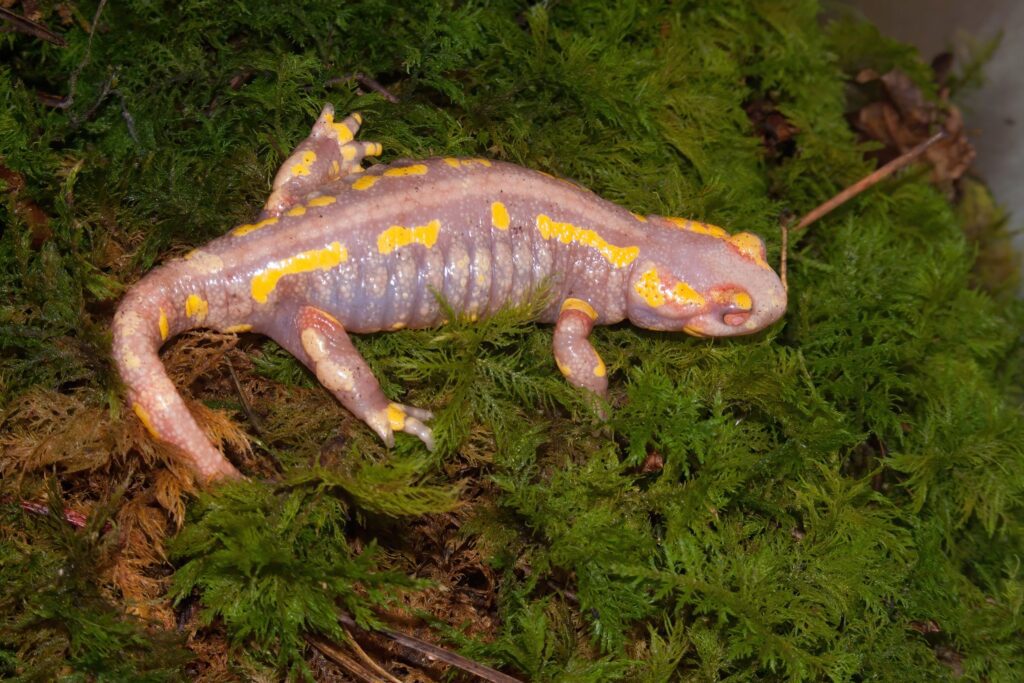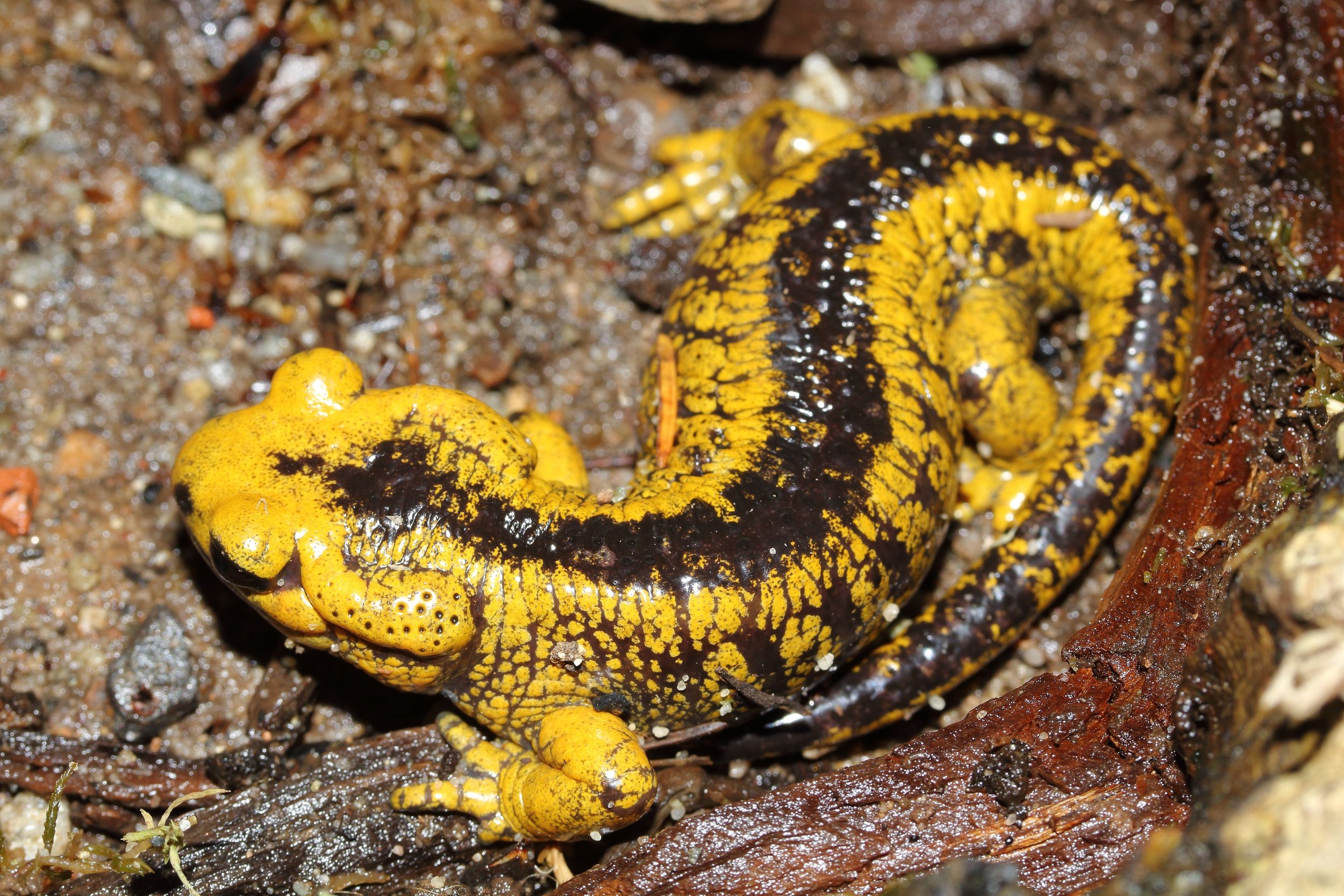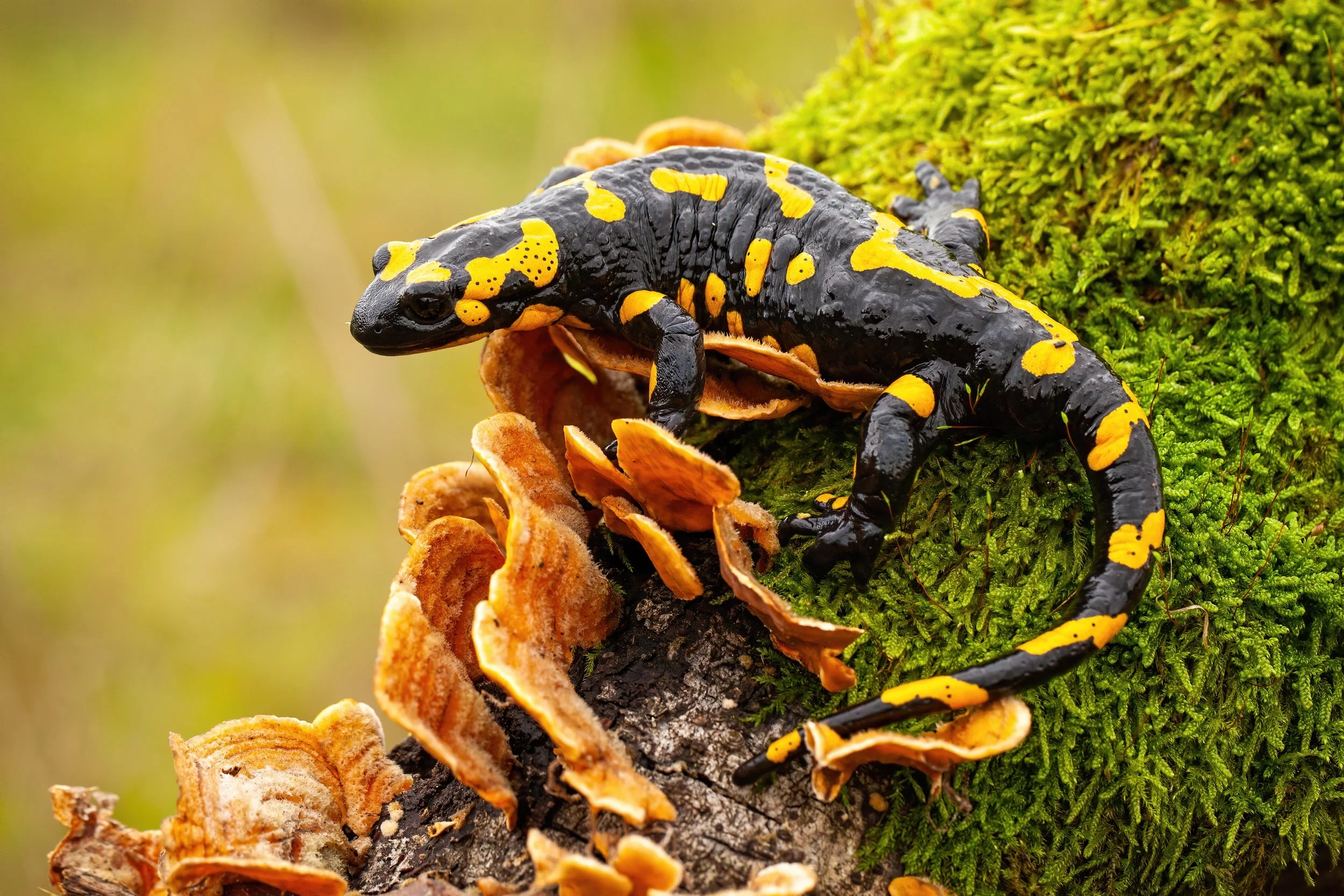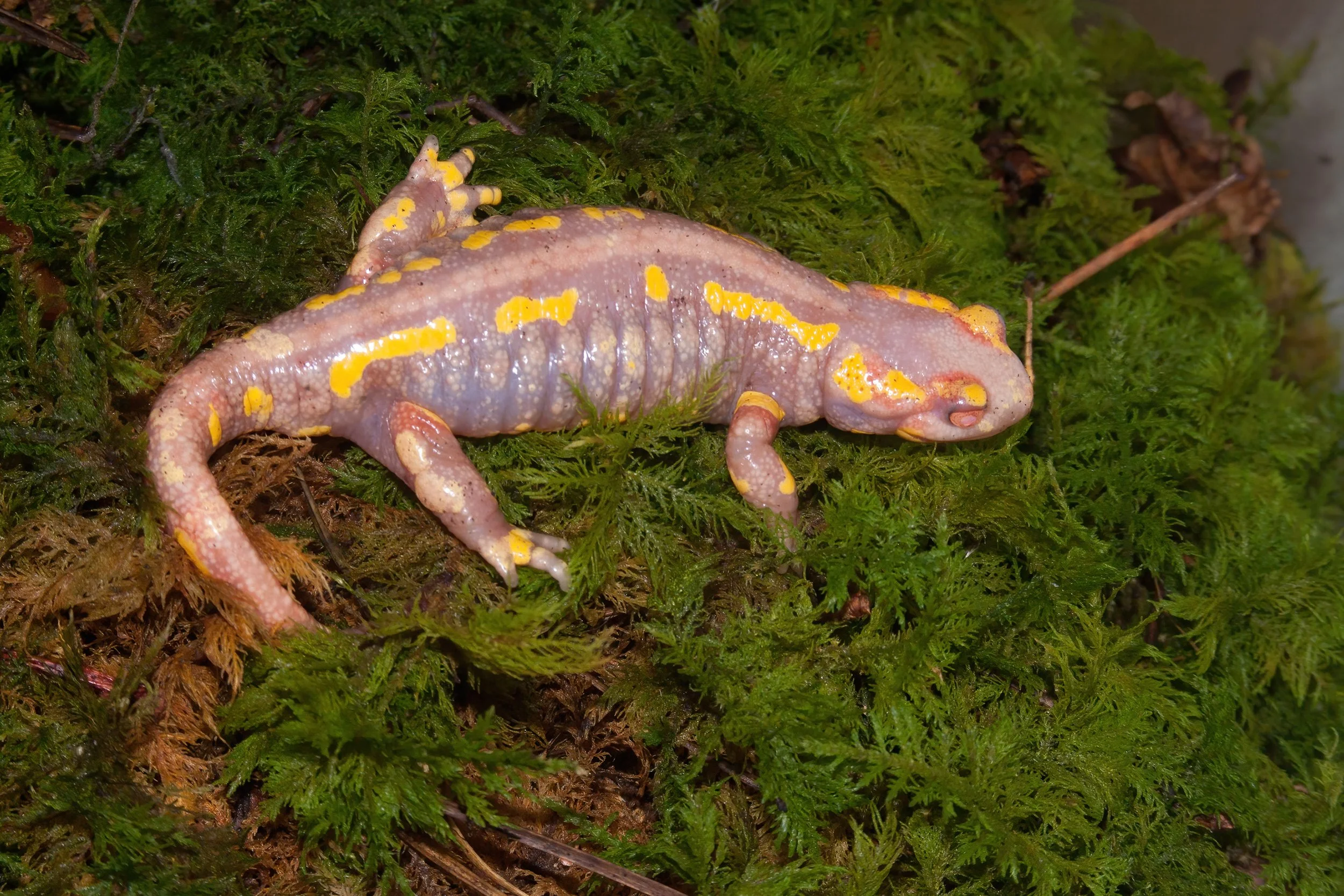The Ultimate Guide to Fire Salamanders
Shrouded in myths and folklore for their seemingly supernatural tendencies to emerge from the flames of bonfires, the natural history of fire salamanders reads like a medieval epic. Populations of this myth-shrouded amphibian were stranded upon mountain tops across Europe as the ice from the last ice age melted. This has created some of the most interesting cases of speciation and subspeciation seen within European herpetofauna.
Salamandra corsica
Speciation and subspeciation
With such a rich tapestry of morphologically and phylogenetically distinct species and subspecies across the continent and well into neighbouring Russia and Africa, understanding the evolutionary history of fire salamanders is particularly interesting. Being temperate amphibians that thrive in cooler climates, populations were isolated following the end of the last ice age. Once a widespread species, as the climate changed and habitats became less hospitable for these salamanders, individual populations were isolated at high altitudes where the climate is cooler. This is particularly apparent in the various species that are found throughout Spain, Portugal and the Middle East. In the warmer climates, each mountain range can be populated by an entirely new species.
The breeding habits of these salamanders also varies greatly depending on the conditions in which they are reproducing. Salamanders that are exposed to temporary pools of water, such as in warmer climates, will often produce fully formed terrestrial offspring. Those from cooler climates with reliable water sources will birth their tadpoles much earlier, allowing them to metamorphose on their own. This is because the eggs are incubated within the mother’s body until it is time for them to hatch. Larger bodied females can also carry more eggs, for a longer period of time, also assisting in the speciation of fire salamanders.
Salamandra salamandra terrestris
Subspecies
Salamandra salamandra terrestris
This species is found across a huge area of France that includes the Rhone valley and Loire valley. Interestingly, these two populations have distinct morphological differences. The individuals from the Rhone valley are generally more robust animals with a heavier build. This species is sometimes called the ‘barred’ fire salamander and has a ‘Solling’ form which is one of the most sought-after of all fire salamanders and can exhibit tri-colour patterns. This form metamorphoses with red patterns that later turn yellow or remain red as the individual grows.
Salamandra salamandra fastuosa
This subspecies is a small to medium sized salamander that can be found across the French and Spanish Pyrenees mountains. Sometimes referred to as the ‘striped’ fire salamander, they typically exhibit pure and clean stripes that extend the entire length of the torso. They will produce mostly tadpoles but have been known to birth fully formed young too.
Salamandra salamandra bejarae
Initially thought to be spread across the entirety of Spain, distribution has been chipped down as new subspecies have been described. Bejarae is a moderately large species. Markings generally don’t follow a particular pattern, they can be blotches of yellow in various shapes as opposed to the more common spots or stripes observed in other subspecies.
Salamandra salamandra morenica
Occurs across the Sierra Marina in South Central Spain. Their distribution is a long narrow strip that follows the mountain range. It is highly possible that the two extremes of the range may produce even more subspecies that are yet to be described to science. Once considered bejerae. Beautiful large growing salamander that produces tadpoles.
Salamandra salamandra gigliolii
An extremely variable subspecies, gigliolii can be almost entirely yellow, giving it a stunning appearance. Found throughout Italy, the southern populations tend to have the brightest markings and colouration. Southern populations are very often entirely yellow. Locally, they are extremely abundant. In fact, being from an area that experiences long droughts, seasonal rains can bring these salamanders out on mass creating quite the spectacle for the amphibian enthusiast.
Salamandra salamandra salamandra
The nominate form of the fire salamander is extremely widespread from East Europe right into Russia. It is a robust animal and exceptionally hardy. With such a wide distribution, it is highly likely that there will be plenty more subspecies to be identified from this animal.
Salamandra salamandra beschkovi
A large robust salamander recently separated from the nominate subspecies Salamandra. Eastern European/ German subspecies. Medium sized and moderately marked with yellow.
Salamandra salamandra gallaica
The Galician fire salamander is extremely variable in its appearance. Individuals can show colours from a mushroom brown all the way through to bright yellows and crimson reds. This species is found in Portugal and adjacent Spain. They are generally a large species that gives birth to large clutches of tadpoles. It often has markings around the head and glands.
Salamandra salamandra crespoi
Crespoi is one of the first of the new wave of newly described subspecies, following the work of taxonomists using DNA analysis. This subspecies is from the Algarve in Portugal and centered around the mountain of Monchique and found at high altitudes. This mountain is the highest point in the Algarve, making it a very isolated population. This eventually differentiated the subspecies from gallaica in the early 1990s.
Salamandra salamandra bernadazi
Small growing subspecies, occurs in northern Spain. Mostly terrestrial young. These animals are very variable in colour completely melanistic to completely yellow with every combination in-between. This species produces fully terrestrial offspring as an adaptation to a particularly hostile environment for depositing tadpoles.
Salamandra salamandra alfredshmidti
Alfredshmidti was broken off from bernadazi in the 90s. They are found in the mountain ranges of Northern Spain and ‘all-yellow’ forms are extremely common. This subspecies regularly produces fully terrestrial young.
Salamandra salamandra almanzoris
This population is centred around the few lakes in central Spain. When it was first described, it was described as an aquatic form. Of course, this is not true, but it does spend much more time in shallow water than other subspecies. Interestingly, these are mostly black with small white markings. Unsurprisingly, this species produces only tadpoles.
Species
Salamandra corsica
This species is a robust and heavily built salamander. As the name suggests, this species is only found on the French island of Corsica. Its head is wider than it is long and exhibits a range of bright yellow patterns. This was one of the first to be described as its own species following a lengthy DNA analysis process by Sebastian Steinfartz that took many years.
Salamandra longirostris
This moderately large species is sometimes referred to as the long-snouted salamander and occurs in southern Spain. Here, it lives exclusively in limestone-rich areas where it is entirely terrestrial and often bathes in water. This species has proven to be a real challenge for keepers, not coping very well in captivity. Those that have succeeded have provided UVB and high levels of calcium. Thus, it is theorised (and not yet scientifically proven) that this species has poor ability to absorb calcium, as the waters in its native range already contains exceptionally high levels of calcium.
Salamandra algira
As the name suggests, this species is found in Northern Africa and has recently been divided into two subspecies S. algira splendens and S. algira tingitana. Both species are found high in the Atmos mountains where the climate is much cooler. Tingitana are dark in colouration, almost entirely black but with bright yellow markings on the head and granular glands. Interestingly, this species also almost always gives birth to fully formed young. Splendens on the other hand, is much longer and slender and has beautiful crimson markings on its head and granular glands. This species gives birth almost exclusively to tadpoles.
Salamandra infraimmaculata
This species is broken into three separate subspecies, all of which are from West Asia, Turkey and Syria. These are some of the largest fire salamanders with the nominate form (S. infraimmaculata infraimmaculata) being the largest of all. In fact, this species grows over 30cm in length and is the most southernly occurring species. It has even been reported that S. infraimmaculata infraimmaculta can birth up to 200 tadpoles per clutch, although 100+ is much more common. At almost 1/3 larger than most fire salamanders and coming from a harsh environment, this maverick survival technique makes complete sense. However, with rising temperatures, the survival rate of this species is dwindling as many of the waterways they deposit tadpoles in will dry up most years, giving them a breeding success rate of just once every 3-5 years.
S. infraimmaculata orientalis is another subspecies which has yellow blotches across the entirety of its body. Finally, S. infraimmaculata semenovi has very fine, reticulated yellow markings. This subspecies also has large clutches but its validity as an individual subspecies has been questioned.
Fire Salamanders in captivity
Here, on this side of the planet, fire salamanders are some of the most popular species to keep and with good reason. Just like the USA’s tiger salamanders (Ambystoma .sp), they require very little maintenance, have stunning patterns and have developed natural fascinations from enthusiasts all over the continent. In Europe, almost all species and subspecies of fire salamander are available and have been kept for generations, however here in the UK that spectrum is narrowed slightly.
Behaviourally, fire salamanders are quite cryptic, opting to stay hidden throughout most of the day. As well as having toxic secretions and delicate skin, their choice to remain hidden most the time makes them terrible pets for anyone expecting to keep an animal that they can observe or interact with. Amphibians should generally be kept away from children due to their delicate nature, but this is even more prevalent with salamanders that may resemble a friendly lizard to a curious child.
Nonetheless, their hardy nature and temperate requirements makes them a brilliant animal to keep both indoors or outdoors in the UK. Furthermore, the recent restrictions on importing salamanders make them an interesting breeding project and one which is often very successful for first-time breeders. Their viviparous (in the case of fastuosa and bernadezi) and ovoviviparous birthing habits make them an extremely rewarding animal to work with.
Care requirements
Creating a perfect fire salamander enclosure is quite straightforward. Aside from the obvious minimum enclosure size requirements which will vary between species, all fire salamanders are cared for in a similar way. These salamanders will thrive in a very basic indoor rub set up, an elaborate bioactive terrarium or even outdoor enclosures, semi-outdoor enclosures, and greenhouses. Of course, outdoor set ups will require a good understanding of species-specific requirements and biosecurity measures, but indoor set ups follow a similar structure.
Indoor enclosures
Previously, the most popular way of keeping fire salamanders was in almost entirely sterile conditions, using paper towels as substrate and cork bark for hides. Interestingly, these animals did extremely well in captivity but the constant necessity of cleaning them out, as well as very little natural enrichment has shifted how most people keep these animals today.
Nowadays, a bioactive set up comprised of a natural soil-based substrate like Bio Life Forest, with a shallow water dish and various cork bark and slate hides is preferable. Substrate can vary from decomposing leaf litter, through to bark-based mixtures. However, this should never stick to the salamander. Dry coir or course bark and sand can stick to the salamander’s skin and cause dangerous levels of stress.
Fire salamanders require no additional heat source and are at more of a risk of overheating than being kept too cool. Like other temperate amphibians, moving the enclosure to a cooler room or placing them on the floor during warmer months is advised. If this is not possible, freezing a water bottle, covering it with a fabric and then placing within the enclosure can also bring the temperature down.
Fire salamanders should always be provided with a water source. However, they are terrible swimmers. Their tail is rounded, meaning they have no propulsion capabilities with this. Water sources should therefore be accessible to walk in and out of. If the salamander is required to climb from the water dish, this can be just as problematic. Providing some cork bark or an artificial ramp that will not become dislodged, is fundamental to preventing any drowning.
Although some species spend more time in damp areas than others and some species inhabit hotter climates than others, this is largely a necessity. For example, the southernly occurring fire salamanders will typically live at higher altitudes and thus cooler temperatures. Therefore, trying to adapt our husbandry to the country of origin of a species, is often ill-advised and a complete guess without scientific research to back up our decisions. That being said, those choosing to house their salamanders outdoors should choose a Northernly species that is typically more resilient to the harsher winters we experience in Western Europe.
Outdoor enclosures
Fire salamanders can be kept extremely successfully outdoors. In fact, it’s very possible to create the perfect enclosure for many of the Northernly species and can be a wonderful feature in the garden. However, there are some crucial considerations to make.
Firstly, the salamanders will rarely be seen. In fact, the only time you’re likely to see the animals is at night, after rain, with a torch. While this is the most natural way of observing the animals, it does mean that opportunities to watch the animals are limited. Furthermore, the keeper will lose a significant amount of control with outdoor vivaria. Meaning if a problem occurs with the animal, it is often too late to resolve by the time the keeper identifies it.
Secondly is security. Not only should the keeper be cautious about birds and predators getting into the enclosure, but with the rise of Bsal, the keeper should also make sure that biosecurity measures are taken to prevent animals or tadpoles from escaping. Fences should be dug deep into the soil or dedicated outdoor vivaria should have at least 5 inches of soil around the bottom and sides of the enclosures. Water must not contaminate nearby rivers and streams, as the pathogens that carry this disease are easily spread. Finally, wild-caught specimens are now banned from entering the UK. Although this means your animal will almost certainly be captive bred, make sure you are 100% sure of this and implement a quarantine procedure if it has come from a larger collection.
Aside from these two points, outdoor keeping is extremely straightforward. Keepers can get great enjoyment from planting ferns and mosses, creating rock walls and water features etc to create the ideal habitat. Species such as S. Salamandra salamandra, S. Salamandra bernadazi and S. Salamandra fastuosa will thrive outdoors, providing they are given a frost-free area to shelter during the coolest months. This can be achieved by creating a polystyrene shelter and filling it with moss and cork bark then burying it into the ground. As long as the entrance point is small enough to avoid a frost, but large enough to allow the salamander to access the hide, the enclosure should be suitable all year round. In the unlikely event that frosts persist, with a long period of -5°C or below, the keeper should consider bringing the animals inside to shelter them from unnecessary extremes.
Diet and nutrition
Fire salamanders are insectivorous, eating mostly soft bodied inverts such as worms, snails and slugs. However, they will also eat crickets which can be quite surprising given their slow-paced characteristics. Providing a wide variety of live foods will give them the best diet but more crucially, ensuring that every feeder insect is gut loaded and dusted to reach a good nutritional profile is absolutely paramount.
Fire salamanders are particularly susceptible to metabolic bone disease. The first instances are often seen when the salamanders back legs become weak and futile. At this point, it has been noted that with the correct medical intervention (providing high quality nutrients etc) people have managed to save their salamander. However, it is much more common that identifying the first symptoms of MBD is a precursor to a premature death.
Because fire salamanders are such stocky animals, they are required to build big skeletons and thus have huge calcium requirements. Using a balanced vitamin and mineral supplement such as Nutrobal, whilst gut-loading feeders on a high-quality formula, will prevent medical issues.







